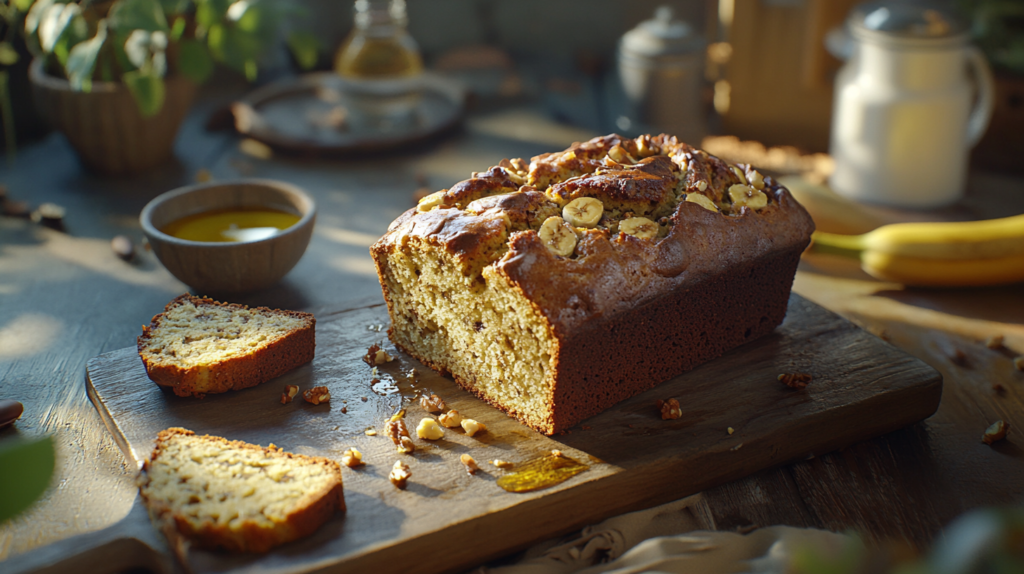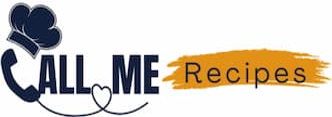Banana bread is the ultimate comfort food—a moist, flavorful treat that’s perfect for breakfast, dessert, or a quick snack. While traditional recipes often call for butter, banana bread made with oil offers a lighter texture, longer shelf life, and a healthier twist. Whether you’re new to baking or a seasoned pro, this guide will take you through the essentials of making the perfect banana bread with oil. Let’s get started! 🍌✨
Introduction to Banana Bread with Oil
Why Use Oil Instead of Butter?
Using oil in banana bread has several benefits:
- Moisture: Oil creates a moist crumb that doesn’t dry out quickly.
- Neutral flavor: Unlike butter, oil lets the banana flavor shine.
- Healthier options: You can use heart-healthy oils like olive or avocado oil for added nutrition.
The History and Popularity of Banana Bread
Banana bread first gained popularity during the Great Depression when creative cooks found ways to use overripe bananas. Today, it’s a beloved recipe around the world, cherished for its versatility and ease.
Benefits of Using Oil in Banana Bread Recipes
- Easier to mix: Oil blends smoothly with other ingredients, reducing prep time.
- Longer freshness: Banana bread made with oil tends to stay fresh longer than butter-based versions.
- Customizable: You can use different oils to experiment with flavor and nutrition.
Block Quote:
“Switching to oil in banana bread isn’t just a small tweak—it’s a game-changer for texture and flavor.”
Essential Ingredients for Banana Bread
Choosing the Right Bananas
The key to great banana bread is ripe bananas. Here’s what to look for:
- Brown spots: Bananas with brown spots are sweet and soft—perfect for mashing.
- Overripe bananas: Even blackened bananas work wonders in banana bread, adding natural sweetness.
Types of Oil to Use: Which is Best?
Not all oils are created equal. Here are some great options:
- Vegetable oil: A neutral, budget-friendly choice.
- Olive oil: Adds a subtle fruity flavor and healthy fats.
- Coconut oil: Creates a slightly tropical flavor and rich texture.
- Avocado oil: A nutrient-dense option with a mild taste.
Pro Tip: Avoid oils with strong flavors, like sesame oil, unless you want them to dominate the dish.
Sweeteners: Sugar, Honey, or Alternatives?
The sweetener you choose can influence the flavor and texture:
- Granulated sugar: Classic and reliable.
- Brown sugar: Adds a hint of molasses and extra moisture.
- Honey or maple syrup: Natural options that bring unique flavors.
- Coconut sugar: A low-glycemic alternative with a caramel-like taste.
Optional Add-ins for Texture and Flavor
- Nuts: Walnuts or pecans add crunch and a nutty flavor.
- Chocolate chips: For a decadent twist. 🍫
- Dried fruit: Raisins or cranberries add chewiness and sweetness.
- Spices: Cinnamon, nutmeg, or cardamom elevate the flavor profile.
Block Quote:
“Banana bread is like a blank canvas—get creative with add-ins to make it uniquely yours!”
Variations of Banana Bread with Oil
Classic Banana Bread with Oil
Stick to the basics: ripe bananas, oil, sugar, flour, eggs, and baking powder. This simple version never fails to impress.
Whole Wheat Banana Bread
Replace some or all of the all-purpose flour with whole wheat flour for a heartier, more nutritious loaf.
Vegan Banana Bread with Oil
Use plant-based milk and flaxseed or applesauce as an egg substitute. Coconut oil works beautifully in this version.
Chocolate Chip Banana Bread
Fold chocolate chips into the batter for a dessert-like loaf that’s sure to please kids and adults alike.
Pro Tip: Dust the chocolate chips with a bit of flour before mixing to prevent them from sinking to the bottom.

Step-by-Step Guide to Making Banana Bread
Making banana bread with oil is straightforward and beginner-friendly. Here’s how to do it step by step for consistently moist and flavorful results.
Preparing Your Ingredients
- Measure everything: Start by measuring all your ingredients to ensure a smooth baking process.
- Mash the bananas: Use a fork or potato masher to mash the bananas until smooth. You should have about 1 cup of mashed banana.
- Preheat the oven: Set your oven to 350°F (175°C). Grease or line your loaf pan with parchment paper for easy removal.
Pro Tip: Prepping your pan beforehand saves time and prevents sticking.
Mixing the Wet and Dry Ingredients
- Combine wet ingredients: In a large bowl, mix the mashed bananas, oil, eggs, sugar, and vanilla extract until smooth.
- Mix dry ingredients: In a separate bowl, whisk together the flour, baking soda, salt, and any spices like cinnamon or nutmeg.
- Blend gently: Add the dry ingredients to the wet mixture in small batches, folding gently with a spatula. Avoid overmixing to keep the bread light and tender.
Pouring and Preparing for Baking
- Pour the batter: Pour the batter into the prepared loaf pan, filling it about three-quarters full.
- Add toppings: If desired, sprinkle the top with chopped nuts, chocolate chips, or a pinch of sugar for a caramelized crust.
Pro Tip: Gently tap the pan on the counter to release air bubbles and ensure an even rise.
Baking and Checking for Doneness
- Bake: Place the pan in the preheated oven and bake for 50-60 minutes. Check for doneness around the 50-minute mark.
- Test with a toothpick: Insert a toothpick into the center of the bread. If it comes out clean or with just a few crumbs, it’s ready.
- Cool: Let the bread cool in the pan for 10 minutes, then transfer it to a wire rack to cool completely before slicing.
Block Quote:
“Patience is key—letting your banana bread cool ensures it holds its shape and slices beautifully.”
Common Problems and Their Solutions
Even with the best intentions, banana bread can sometimes go awry. Here’s how to fix common issues.
Too Dense: How to Achieve a Lighter Texture
If your banana bread feels too dense, try these tips:
- Don’t overmix: Overmixing develops gluten in the flour, leading to a heavy texture.
- Check your leavening agent: Make sure your baking soda or powder is fresh. Stale leavening agents won’t give the necessary lift.
- Use the right flour: All-purpose flour works best for a light and airy loaf.
Too Dry: Keeping Your Banana Bread Moist
A dry banana bread can be disappointing. Avoid this with these techniques:
- Add moisture: Use oil instead of butter, and include a splash of milk or yogurt if the batter feels thick.
- Don’t overbake: Keep a close eye on the baking time and test for doneness early.
- Cover with foil: If the top browns too quickly, cover it with foil halfway through baking to retain moisture.
Pro Tip: Store your banana bread wrapped in plastic or foil to prevent it from drying out.
Uneven Baking: Tips for Even Cooking
If your banana bread is raw in the center but overcooked on the edges:
- Use the right pan: A metal loaf pan conducts heat evenly, while glass or ceramic pans may require longer baking times.
- Distribute heat: Place your pan in the center of the oven for even airflow.
- Check the oven temperature: Use an oven thermometer to ensure accurate temperature settings.
Enhancing Your Banana Bread with Spices
Spices can transform your banana bread from basic to bold. Here are some ideas:
- Cinnamon: Adds warmth and depth.
- Nutmeg: A subtle nutty spice that complements bananas.
- Ginger: For a slight zing and complexity.
Pro Tip: Start with small amounts (½ teaspoon) and adjust to your taste.
Storing and Freezing Banana Bread
Banana bread is even better the next day! Here’s how to store it:
- Room temperature: Wrap it tightly in plastic or foil and store it on the counter for up to 3 days.
- Refrigerate: Extend freshness by refrigerating it in an airtight container for up to a week.
- Freeze: Slice the bread and wrap each piece individually in plastic wrap, then store in a freezer-safe bag. Frozen banana bread lasts up to 3 months.
Pro Tip: Thaw frozen slices in the microwave for 20 seconds for a quick, warm treat.
Tips for Perfect Banana Bread
Even the simplest recipes can be improved with a few expert tips. Here’s how to make your banana bread stand out every time.
Using Ripe Bananas Effectively
- Freeze overripe bananas: If your bananas are too ripe to use immediately, freeze them. When ready to bake, thaw them at room temperature.
- Mash well: The smoother the banana mash, the more evenly it will integrate into the batter.
- Don’t waste the liquid: When thawing frozen bananas, keep the liquid—they add extra moisture and flavor.
Enhancing the Recipe with Spices
Spices elevate the flavor of banana bread:
- Cinnamon and nutmeg: A classic combination that adds warmth.
- Cardamom: A slightly floral spice that pairs well with bananas.
- Cloves: Use sparingly for a deep, aromatic note.
Pro Tip: Experiment with spice blends like pumpkin pie spice or chai masala for a unique twist.
Storing and Freezing Banana Bread
Proper storage ensures your banana bread stays moist and fresh:
- Short-term storage: Wrap the loaf in plastic wrap or foil and store at room temperature for up to three days.
- Long-term storage: For extended freshness, slice the bread, wrap each slice individually, and freeze for up to three months.
- Reheating tips: Warm slices in the oven or microwave to bring back their fresh-baked flavor.
Block Quote:
“The beauty of banana bread is that it tastes even better the next day—if it lasts that long!”
Health Benefits of Banana Bread with Oil
Banana bread with oil isn’t just delicious; it also comes with some surprising health perks.
Nutritional Advantages of Oil-Based Recipes
Switching to oil has several health benefits:
- Healthier fats: Oils like olive or avocado are rich in monounsaturated fats, which support heart health.
- Moisture retention: Oil keeps the bread moist without adding unnecessary calories.
- Vitamin boost: Some oils, like sunflower and canola, are high in vitamin E.
Adding Healthy Ingredients for a Boost
Incorporate these healthy add-ins to make your banana bread even more nutritious:
- Chia seeds: A great source of omega-3s and fiber.
- Flaxseeds: Add a nutty flavor and extra nutrients.
- Greek yogurt: Boosts protein while keeping the bread moist.
- Oats: Sprinkle rolled oats into the batter for added texture and fiber.
Pro Tip: Swap half the flour for whole wheat to increase fiber and make the bread heartier.
Frequently Asked Questions (FAQs)
Can I Substitute Butter for Oil?
Yes, you can substitute butter for oil in banana bread, but it will slightly alter the texture and flavor:
- Butter adds richness: It creates a denser loaf with a more pronounced flavor.
- Oil adds moisture: Keeps the bread lighter and softer for longer.
- Ratio: Use the same amount of butter as oil (e.g., ½ cup of butter for ½ cup of oil).
What is the Best Oil for Banana Bread?
The best oil depends on your flavor preferences:
- Neutral oils: Canola or vegetable oil work for classic banana bread.
- Flavorful oils: Coconut or olive oil add unique taste and richness.
- Health-conscious oils: Avocado oil is nutrient-dense and mild in flavor.
Pro Tip: Always use fresh oil to avoid any off flavors in your banana bread.
How Long Does Banana Bread Last?
Banana bread has a good shelf life when stored properly:
- Room temperature: 2-3 days in an airtight container.
- Refrigerator: Up to 1 week.
- Freezer: Up to 3 months when properly wrapped.
Pro Tip: To keep the bread moist, store it with a piece of parchment paper between slices.
Explore More Recipes to Complement Your Banana Bread with Oil
Are you looking for additional recipes to complement your banana bread recipe with oil? Here are some delightful ideas to inspire your next baking or cooking adventure:
- Simply Recipes Banana Bread: The Ultimate Guide to Perfect Banana Bread – Explore another variation of banana bread for comparison and inspiration.
- Banana Brownie Recipe: A Delicious Twist on the Classic Brownie – Pair your banana bread with this chocolaty treat for a perfect dessert duo.
- Oatmeal Brownie Recipe: A Healthier, Delicious Twist on Traditional Brownies – Try a healthier yet indulgent option alongside your banana bread.
- Coconut Custard Pie Recipe: A Creamy, Delicious Dessert – A tropical dessert to add variety to your baking repertoire.
- Mango Dessert Recipes: Sweet and Refreshing Treats for Every Occasion – Discover refreshing mango desserts that pair wonderfully with the rich flavors of banana bread.
Check out these recipes to add more variety and sweetness to your culinary creations!
Conclusion: Why You Should Try Banana Bread with Oil
Banana bread with oil is a game-changer in the world of baking. Its moist texture, extended freshness, and customizable nature make it a recipe you’ll return to again and again.
Whether you’re sticking to the classic version or experimenting with add-ins like chocolate chips, spices, or nuts, banana bread with oil offers endless possibilities. It’s not just a recipe—it’s a way to transform simple ingredients into something comforting, delicious, and wholesome.
So, grab those overripe bananas, pick your favorite oil, and preheat your oven. It’s time to bake banana bread that’s not only tasty but also tailored to your preferences. Trust me, your kitchen will smell amazing, and your taste buds will thank you. 🍌✨

